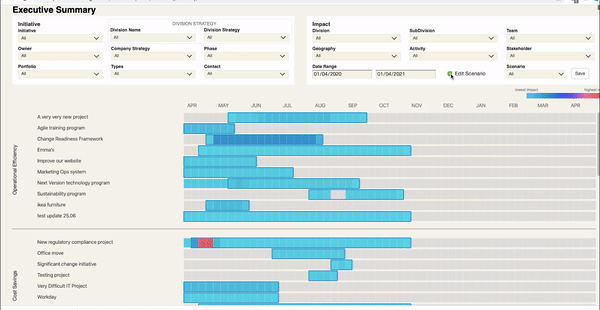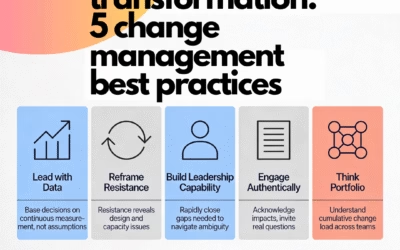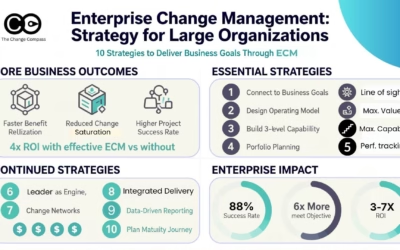Managing a set of change initiatives through a systematic approach in the project intake process and portfolio management process, often outlined in a table of contents, is relatively new for some organizations. This strategic approach is drawn from the portfolio project management method by dividing a set of initiatives into different teams and viewing various project ideas and initiatives in unison. By doing this, organizations can make more informed decisions, allowing things to become more manageable from the perspective of planning how to organize the strategic objectives and business goals of the planning and sequencing of these changes.
Project portfolio managers are focused on investment funding, program management, governance, project execution, project selection, and resource allocation, including selecting the best individual projects related to the best projects and those related projects endeavors. For portfolio change managers, there are similar focus areas such as change program management, change initiative execution, resource management, and quality assurance. However, there are also several marked differences, including a focus on business change governance, business change capability, change leadership, and change tools and methodology.
In practice, there is often a wide range of practices in the service delivery and model of portfolio change management. Some focus purely on supporting project delivery and provide valuable insights, and in the process fail to uplift business change capability. Others tend to focus on general change capability through training and development and very little on change governance and supporting strategy implementation.
So, what are some of the best practices in strategic portfolio management that align with strategic organizational goals and change portfolio management by coordinating with individual project managers in achieving a strategic portfolio of projects that support strategic goals and overall business strategy? How does the change portfolio management function position itself to be strategic, value-adding, and seen as a driver of business results? Here are 10 best practices.

1. Use hard data.
A lot of change professionals often shy away from data. We prefer to focus on behavior, leadership, mindsets, norms, and culture. Whilst the ‘soft’ things may matter we need to be comfortable in working with data. Peter Drucker’s famous saying goes ‘What gets measured gets done’.
Disciplines with a strong focus on data usually have a strong seat at the business table. For example, Finance, Operations, and Sales. Even Marketing is not just about creative ideas and concepts, but there is a strong focus on cost, revenue forecast, and customer responses. Armed with data that drives business decisions you get a strong seat at the decision-making table.
What types of data should portfolio change managers focus on? The standard change measures include training attendance, stakeholder ratings, and arbitrary business readiness ratings. To really demonstrate value, portfolio change managers need to turn change management into a science and be able to quantify change to inform investment decisions effectively. Change Impacts is one great example. By quantifying change impacts into discrete units one can start to measure and understand what changes are and how they move over time and across different parts of the business.
2. Link change practices with business outcomes
Continuing from the previous point – armed with quantitative change impact data, the portfolio change manager is able to analyze the data to find any correlations between change impact data and business performance data. This can become a very powerful picture to take to the senior management team – drawing out the impact of changes on business performance.
Based on data from The Change Compass. An organization has been able to draw significant correlations between change impacts and customer satisfaction levels. This has since raised meaningful discussions regarding the approach of implementing changes and how to mitigate any potential negative impacts on the customer experience. It does not necessarily mean minimize on change impacts on the customer. Instead, it challenges the group to think through how to better engage and prepare for the customer to transition through changes. This is a great example of demonstrating the importance of linking change impacts with business outcomes.
3. Focus on building change capability more than just execution
A lot of organizations treat change management as only discrete pieces of work that need to be carried out as a part of a project. With this approach, these organizations have hired mainly contractors with some permanent change managers purely focused on project execution. Whilst this work is absolutely required to successfully land initiatives, these resources come and go and in the end, the organization is often no better off in managing change.
Instead, there needs to be a continual focus on developing business change capability. This may be carried out in different ways. With each project implementation, the change manager may focus on uplifting change management capabilities in the business within its leaders. Effective engagement and learning channels can be established to better aid the deployment of change initiatives. These include self-paced training systems, know-how regarding establishing and measuring various learning interventions, and different types of employee engagement channels, both face-to-face and digital.
As change portfolio managers, a concerted focus on embedding business change capability can ensure that the business becomes more mature at undergoing change. A strategic plan can be developed that includes different ways of targeting capability uplift and change maturity. This requires business sponsorship and focus. It is also a critical part of effective operational management.

4. Design and manage change governance
Establishing effective change governance does not mean complicated multi-level governance with lots of documentation, policies, and procedures and lots of headcounts to manage the processes. Change governance means having the right processes to ensure there is sufficient oversight and visibility on what changes are going to happen and the effectiveness of change delivery.
Different organizations will establish different governance processes to suit the particular cultural and business environment. However, at the most basic level, there should be a regular cadence where managers can see and visualize the changes that are going to happen, and discuss any risks and issues with the picture they are seeing. At the same cadence, there should also be a review of the previous changes and how they’ve been rolled out, with a view to identifying opportunities for improvement.
There should also be different levels of change governance for larger organizations. For a business unit, there should be a change governance focusing on changes within the business unit. There should also be an enterprise-level change governance focused on changes across the organization. At the enterprise level, the discussion will be on strategic initiatives that run across the company. There should also be discussions on any risks and issues with business readiness and the progress of the change.
A standard meeting agenda for change governance would include the following:
- Review the previous month’s changes including callouts of highlights, challenges, employee engagement, results, and overall progress
- Examining metrics around the amount of change and to what extent the level of changes can be digested by the business appropriately
- Identifying potential contentions of concurrent changes within the plan. If concurrent changes are being released into the business, discussions should zoom in on the quantum and nature of change contention, rationale as to why the business may not be able to handle the volume of changes, and implications if the releases were to proceed
- Examining the data to ensure that all changes are captured and there is nothing missing. Change data should contain key projects being implemented, BAU changes, and other corporate programs from groups such as IT or HR
- Examining the overall upcoming change slate and identify upcoming risks and opportunities as a part of risk management. Opportunities may include potential gaps where there is very little change, and where there may be opportunities for initiatives to land
5. Leverage digital tools
Change portfolio managers manage the slate of projects using a structured process of funding, prioritization, analysis, and review based on data, ensuring strategic alignment with business objectives and maximizing business value. In a similar vein, so should change portfolio managers, particularly when considering insights from project proposals and a project management office. The power that change managers have is not around cost or schedule data; it is on change impact and change readiness as discrete data points, including the crucial role of the contributions of team members. The challenge is how to collect, analyze, present, and leverage the power of these data.
The Change Compass is a change portfolio management software that quantifies and packages change impacts into data that can be easily analyzed and presented in various visual formats to decision-makers in real time, as a part of effective portfolio management. Visuals are specifically designed to make people change decisions, and are not just simple headlamps or Gantt charts. Initiative owners who own the source of the information update change impact data. Up-to-date change impact project data can be accessed at any time with reporting generated automatically. The portfolio change manager can easily dissect, drill down, and cut data to find out the change health of the portfolio:
- Is there too much change?
- How is our staffing resource impacted by change activities (especially for resource-sensitive areas such as call centres)
- What’s the change tolerance level for the business?
- How are various stakeholder groups impacted by the changes?
- How are initiatives under particular strategic themes impacting the business?
- How are customers and their respective experiences impacted by our initiatives?

6. Examine customer impacts
At a portfolio level, it is not sufficient to just focus on internal employee and stakeholder impacts. The change portfolio management team manager also needs to place focus on how are customers impacted by the planned changes. This drives at the core of the focus of a lot of the organizations on the customer.
One large financial services organization that was focused on customer experiences started analyzing data on customer change impacts across initiatives. Through this, there was a significant realization that the same group of customers was impacted by 6 significant initiatives at the same time. Across each of these initiatives, there was no coordination and the silo approach meant that poor synchronization and coordination could lead to a very poor customer experience. Subsequently, new roles and remits were created to manage this customer experience through facilitating a coordinated approach to planning and implementing initiative rollout.
7. Iterative planning
Iterative planning is a core of agile ways of working. At the core of iterative planning is the belief that we don’t always know the solution that we are striving for at the beginning of the change initiative. It is when we start testing and getting feedback from users that we are able to refine our proposal and be able to come up with a solution that suits the organization.
To truly support agile ways of working, change management needs to be able to develop prototypes of the change approach, and be able to morph or tweak the approach as required based on feedback. For example, a change approach can be tested on a particular team, the change champion group, or a selected trial group. Communication and engagement approaches as well as learning approaches can be tested in these groups.
Want to learn more about managing change portfolios?
Managing change as a change driver
Managing change as a change receiver
Ultimate guide to change portfolio management
If you’re ready to start to manage a portfolio of change initiatives using data and insights, have a chat to us about how to leverage The Change Compass capabilities to help you pinpoint key risks and opportunities in managing across initiatives. To book a demo click here.






